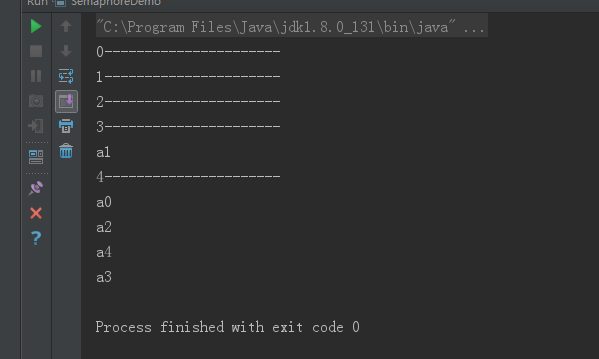在Java的并发包中,Semaphore类表示信号量。Semaphore内部主要通过AQS(AbstractQueuedSynchronizer)实现线程的管理。Semaphore有两个构造函数,参数permits表示许可数,它最后传递给了AQS的state值。线程在运行时首先获取许可,
如果成功,许可数就减1,线程运行,当线程运行结束就释放许可,许可数就加1。
如果许可数为0,则获取失败,线程位于AQS的等待队列中,它会被其它释放许可的线程唤醒。在创建Semaphore对象的时候还可以指定它的公平性。
一般常用非公平的信号量,非公平信号量是指在获取许可时先尝试获取许可,
而不必关心是否已有需要获取许可的线程位于等待队列中,如果获取失败,才会入列。
而公平的信号量在获取许可时首先要查看等待队列中是否已有线程,如果有则入列。
先看测试案例:
package com.cxy.cyclicBarrier; import java.util.concurrent.ExecutorService; import java.util.concurrent.Executors; import java.util.concurrent.Semaphore; import java.util.concurrent.TimeUnit; /** * Created by Administrator on 2017/4/10. */ public class CxyDemo { private final static int threadCount = 20; public static void main(String[] args) throws Exception { ExecutorService exec = Executors.newCachedThreadPool(); final Semaphore semaphore = new Semaphore(3); for (int i = 0; i < threadCount; i++) { System.out.println(i+"----------------------"); final int threadNum = i; exec.execute(() -> { try { if (semaphore.tryAcquire(5000, TimeUnit.MILLISECONDS)) { // 尝试获取一个许可 test(threadNum); semaphore.release(); // 释放一个许可 } } catch (Exception e) { // log.error("exception" , e); System.out.println(e); } }); } exec.shutdown(); } private static void test(int threadNum) throws Exception { // log.info("{}" , threadNum); System.out.println("a"+threadNum); Thread.sleep(100); } }
执行结果:

源码分析:
构造方法:
public Semaphore(int permits) { sync = new NonfairSync(permits); } /** * Creates a {@code Semaphore} with the given number of * permits and the given fairness setting. * * @param permits the initial number of permits available. * This value may be negative, in which case releases * must occur before any acquires will be granted. * @param fair {@code true} if this semaphore will guarantee * first-in first-out granting of permits under contention, * else {@code false} */ public Semaphore(int permits, boolean fair) { sync = fair ? new FairSync(permits) : new NonfairSync(permits); }
第一个构造方法:是允许的信号量
第二个,里面传入的boolean参数,采用的是公平锁还是分公平锁
tryAcquire源码
public boolean tryAcquire(long timeout, TimeUnit unit) throws InterruptedException { return sync.tryAcquireSharedNanos(1, unit.toNanos(timeout)); } public final boolean tryAcquireSharedNanos(int arg, long nanosTimeout) throws InterruptedException { if (Thread.interrupted()) throw new InterruptedException(); return tryAcquireShared(arg) >= 0 || doAcquireSharedNanos(arg, nanosTimeout); } private boolean doAcquireSharedNanos(int arg, long nanosTimeout) throws InterruptedException { if (nanosTimeout <= 0L) return false; final long deadline = System.nanoTime() + nanosTimeout; final Node node = addWaiter(Node.SHARED); boolean failed = true; try { for (;;) { final Node p = node.predecessor(); if (p == head) { int r = tryAcquireShared(arg); if (r >= 0) { setHeadAndPropagate(node, r); p.next = null; // help GC failed = false; return true; } } nanosTimeout = deadline - System.nanoTime(); if (nanosTimeout <= 0L) return false; if (shouldParkAfterFailedAcquire(p, node) && nanosTimeout > spinForTimeoutThreshold) LockSupport.parkNanos(this, nanosTimeout); if (Thread.interrupted()) throw new InterruptedException(); } } finally { if (failed) cancelAcquire(node); } }
release源码
public void release() { sync.releaseShared(1); } public final boolean releaseShared(int arg) { if (tryReleaseShared(arg)) { doReleaseShared(); return true; } return false; } private void doReleaseShared() { /* * Ensure that a release propagates, even if there are other * in-progress acquires/releases. This proceeds in the usual * way of trying to unparkSuccessor of head if it needs * signal. But if it does not, status is set to PROPAGATE to * ensure that upon release, propagation continues. * Additionally, we must loop in case a new node is added * while we are doing this. Also, unlike other uses of * unparkSuccessor, we need to know if CAS to reset status * fails, if so rechecking. */ for (;;) { Node h = head; if (h != null && h != tail) { int ws = h.waitStatus; if (ws == Node.SIGNAL) { if (!compareAndSetWaitStatus(h, Node.SIGNAL, 0)) continue; // loop to recheck cases unparkSuccessor(h); } else if (ws == 0 && !compareAndSetWaitStatus(h, 0, Node.PROPAGATE)) continue; // loop on failed CAS } if (h == head) // loop if head changed break; } }